Topics
Reproduction in Lower and Higher Plants
- Reproduction
- Mode of Reproduction in Plant
- Asexual Reproduction in Plant
- Vegetative Reproduction
- Natural Vegetative Reproduction
- Artificial Vegetative Reproduction
- Sexual Reproduction in Flowering Plants
- Pre-fertilization in Plant: Structure and Events
- Pre-fertilization in Plant: Stamen (Male Reproductive Unit)
- Pre-fertilization in Plant: Microsporangium
- Structure of Microspore Or Pollen Grain
- Pre-fertilization in Plant: Pistil (Female Reproductive Unit)
- Pre-fertilization in Plant: Megasporangium
- Pre-fertilization in Plant: Formation of Embryo Sac
- Pollination
- Self Pollination (Autogamy)
- Cross Pollination
- Agents of Pollination
- Outbreeding Devices
- Pollen Pistil Interaction
- Fertilization Process
- Post Fertilisation in Plant: Structures and Events
- Development of Endosperm
- Post Fertilization in Plant: Development of Embryo (Embryogeny)
- Formation of Seed and Fruit
- Apomixis
- Parthenocarpy
- Polyembryony
- Kinds of Pollination
Reproduction in Lower and Higher Animals
- Reproduction
- Mode of Reproduction in Animal
- Asexual Reproduction in Animal
- Sexual Reproduction in Animals
- Human Reproduction
- The Male Reproductive System
- The Female Reproductive System
- Menstrual Cycle (Ovarian Cycle)
- Gametogenesis
- Fertilization in Human
- Embryonic Development in Human
- Implantation in Human
- Pregnancy in Humans
- Placenta (Growth) in Human
- Parturition (Birth) in Human
- Lactation in Human
- Reproductive Health
- Population Stabilisation and Birth Control
- Medical Termination of Pregnancy (MTP)
- Sexually Transmitted Diseases (STD)
- Infertility
- Gastrulation in humans
Inheritance and Variation
- Heredity or Inheritance
- Gregor Johann Mendel – Father of Genetics
- Genes and Genetic
- Mendelian Inheritance - Mendel’s Law of Heredity
- Back Cross and Test Cross
- Deviations from Mendel’s Findings
- Chromosomal Theory of Inheritance
- Chromosomes - The Carriers of Heredity
- Linkage and Crossing Over
- Autosomal Inheritance
- Sex Linked Inheritance
- Sex Determination
- Genetic Disorders
Molecular Basis of Inheritance
- Deoxyribonucleic Acid (DNA) and Its Structure
- The Genetic Material is a DNA
- Packaging of DNA Helix
- DNA Replication
- Protein Synthesis
- Regulation of Gene Expression
- Operon Concept
- Genomics
- Human Genome Project
- DNA Fingerprinting Technique
- Genetic Code
Origin and Evolution of Life
- Origin and Evolution of Universe and Earth
- Theories of Origin of Life
- Chemical Evolution of Life (Self-assembly Theory of the Origin of Life)
- Darwinism
- Mutation Theory
- Modern Synthetic Theory of Evolution
- Organic Evolution
- Hardy Weinberg’s Principle
- Adaptive Radiation
- Evidences for Biological Evolution
- Speciation
- Geological Time Scale
- Human Evolution
- Theories of Biological Evolution
Plant Water Relation
- Plant Water Relation
- Properties of Water
- Water absorbing organ
- Water Available to Roots for Absorption
- Means of Transport in Plants
- Concept of Imbibition
- Simple Diffusion
- Concept of Osmosis
- Osmotic Pressure
- Facilitated Diffusion
- Turgidity and Flaccidity (Plasmolysis)
- Active Transport
- Passive Transport
- Water Potential (ψ)
- Path of Water Across the Root
- Translocation of Water (Ascent of Sap)
- Transport of Mineral Ions
- Transport of Food
- Transpiration
- Types of Transpiration
- Structure of Stomatal Apparatus
- Significance of Transpiration
Plant Growth and Mineral Nutrition
- Plant Growth
- Phases of Plant Growth
- Conditions Necessary for Plant Growth
- Plant Growth Rate
- Plant Growth Curve
- Differentiation, De-differentiation, Re- Differentiation
- Plant Development
- Plant Plasticity
- Plant Hormones
- Types of Plant Hormones: Auxins
- Types of Plant Hormones: Gibberellins
- Types of Plant Hormones: Cytokinins
- Types of Plant Hormones: Ethylene
- Types of Plant Hormones: Abscisic Acid (ABA)
- Photoperiodism
- Vernalization (Yarovization)
- Plant Mineral Nutrition
- Nitrogen Cycle
Respiration and Circulation
- Respiration
- Organs of Respiratory Exchange
- Human Respiratory System
- Mechanism of respiration-Breathing
- Regulation of Breathing / Respiration
- Modified Respiratory Movements
- Disorders of Respiratory System
- Transportation in Living Organisms
- Circulation in Animals
- Types of Closed Circulation
- Blood Circulatory System in Human
- Composition of Blood: Plasma (The Liquid Portion of Blood)
- Composition of Blood: Red Blood Cells (Erythrocytes)
- Composition of Blood: White Blood Cells (Leukocytes)
- Composition of Blood: Blood Platelets (Thrombocytes)
- Function of Platelets - Clotting of Blood (Coagulation)
- Human Heart
- Working mechanism of human heart
- Blood Vessels
- Blood Pressure (B.P.)
- Electrocardiogram (ECG)
- Lymph and Lymphatic System
- Mechanism of respiration - Internal respiration
- Mechanism of respiration - External respiration
- Mechanism of respiration - Cellular respiration
Control and Co-ordination
- Control and Co-ordination
- Nervous System in Hydra
- Nervous System in Planaria (Flatworm)
- Neural Tissue
- Neuron (Or Nerve Cell) and Its Types
- Neuroglial Cells (Or Glial Cells)
- Human Nervous System
- Central Nervous System (CNS)
- The Human Brain - Forebrain
- The Spinal Cord
- Peripheral Nervous System (PNS)
- Sensory Receptors
- Human Eye
- Human Ear
- Disorders of Nervous System
- Chemical Coordination
- Human Endocrine System
- The Hypothalamus
- Pituitary Gland or Hypophysis Gland
- The Pineal Gland
- Thyroid Gland
- Parathyroid Gland
- Thymus Gland
- Adrenal Gland (Suprarenal Gland)
- Pancreas (Islets of Langerhans)
- Reproductive Glands (Gonads)
- Synapse - Properties of nerve fibres
- Synapse - Types of synapse
- Transmission of nerve impulse
- Generation of nerve impulse
- Reflex Action
- Autonomic Nervous System (ANS)
- Diffuse Endocrine Glands
Human Health and Diseases
- Defence System in Our Body: Immune System
- Immunity
- Types of Immunity
- Vaccination and Immunization
- Structure of Antibody
- Disease
- Protozoan Diseases
- Helminthic Diseases
- Bacterial Diseases
- Viral Diseases
- Fungal Diseases
- Vector Borne Diseases
- Cancer
- Adolescence
- Addiction
- Drug Abuse
Enhancement of Food Production
- Improvement in Food Production
- Plant Breeding
- Tissue Culture
- Single Cell Protein (SCP)
- Biofortification
- Animal Husbandry (Livestock)
- Animal Breeding
- Dairy Farming
- Poultry Farming
- Apiculture (Bee Farming)
- Pisciculture (Fish Farming)
- Sericulture
- Lac Culture
- Microbes in Human Welfare
- Microbes in Industrial Production
- Microbes in Sewage Treatment
- Microbes in Energy Generation
- Microbes as Biocontrol Agents
- Microbes as Biofertilizers
Biotechnology
- Biotechnology
- Process and Principles of Biotechnology
- Methodology for rDNA Technology
- Commercial Applications of Biotechnology
- Bioethics
- Effects of Biotechnology on the Environment
- Biopatent and Biopiracy
- Transgenic Plants
- Transgenic animals
- Effects of Biotechnology on Human Health
- Tools and techniques for gene cloning/ rDNA technology
Organisms and Populations
- Organisms and the Environment Around
- Habitat
- Niche
- Structure and function of an Ecosystem
- Adaptations and Its Types
- Population
- Population Interactions
- Organisms and Populations
Ecosystems and Energy Flow
- Ecosystem
- Structure and function of an Ecosystem
- Concept of Energy Flow in an Ecosystem
- Classification of Animal
- Trophic Level
- Food Chain
- Food Web
- Ecological Pyramids
- Nutrient Cycles
- Ecological Succession
- Ecosystem Services
- Productivity
- Decomposition
- Phosphorus Cycle
- Carbon Cycle
Biodiversity, Conservation and Environmental Issues
- Biodiversity
- Levels of Biodiversity
- Patterns of Biodiversity
- Biodiversity Current Scenario
- Loss of Biodiversity
- Conservation of Wildlife
- Biological Diversity Act, 2002
- Environmental Issues
- Air Pollution and Its Causes
- Noise Pollution
- Water Pollution and Its Causes
- Green House Effect
- Preventive Measures of Green House Effect
- Global Warming
- Preventive Measures of Global Warming
- Ozone Layer Depletion
- Deforestation and Its Causes
- Mission Harit Maharashtra
- Conservation of Biodiversity
Excretion and Osmoregulation
- Modes of Excretion: Ammonotelism, Ureotelism, and Uricotelism
- Human Excretory System
- Function of the Kidney - “Production of Urine”
- Regulation of Kidney Function
- Common Disorders of the Urinary System
Human Reproduction
- Evidence for Biological evolution:
- Paleontological evidence
- Evidence from Morphological and anatomical evidence
- Embryological evidence
- Molecular evidence
- Evolution by natural selection (Industrial melanism)
- Evolution by anthropogenic
Notes
Evidence for Biological Evolution:
1. Paleontological evidence:
- The study of fossils is called palaeontology.
- According to Charles Lyell, Fossils are impressions or remains of hard parts of life-forms found in rocks.
- Rocks form sediments and a cross-section of earth's crust indicates the arrangement of sediments one over the other during the long history of the earth. Such types of rocks are called sedimentary rocks.
- Most fossils are found in sedimentary rocks.

- Different-aged rock sediments contain fossils of different life forms who probably died during the formation of the particular sediment.
- A study of fossils in different sedimentary layers indicates the geological period in which they existed.
- Some of them represent extinct organisms (e.g., Dinosaurs).
- The study shows that life forms varied over time and certain life forms are restricted to certain geological time spans.
- New forms of life have arisen at different times in the history of the earth. i.e., evolution has taken place.
- Generally, fossils found in older rocks are of simpler types and those found in newer rocks are of complex types.
- By fossils, we can study the evolutionary pedigree of animals like horses, elephants and men etc.
- The geological history of the earth closely correlates with the biological history of the earth.
Type of Fossils:
- Unaltered fossils: Fossils which are preserved in their original or intact form in ice, amber, etc.
e.g., 1) Wooly mammoths found frozen in ice (25000 years before extinct fossils were found from the Siberian region).
- Petrified fossils: Replacement of organic or soft parts of dead organisms by mineral deposits is called petrification. Here only the hard parts like bones, teeth, shells, and wood etc. Get preserved, which are called petrified fossils. These are the most common types of fossils.
- Mould fossils: Only an impression of the external structure of body is preserved in wet soil and no body part is recovered of dead organisms.
- Cast fossils: Sometimes minerals are filled in the mould, resulting in cast fossils.
- Print fossils: Fossilized impressions of foot, wings, leaves, stem etc.
- Coprolites: Preserved faeces or excreta of organisms.
Archaeopteryx:
- It is a missing link between reptiles and birds.
- The connecting links which are not found in present times are called as Missing links.
- Its fossil was discovered by Andreas Wagner from Bavaria in Germany.
- It was found in the rocks of Jurassic period.
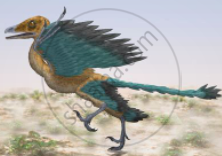
Reptilian Characters:
- Long lizard like tall with free caudal vertebrae.
- Non-pneumatic bones
- Weak sternum
- Teeth present in jaw
Avian Characters:
- Feathers on body
- Jaws modified into beak
- Forelimbs modified into wings (reduced)
- Hind limbs built in avian plan
Evolution (Pedigree) of horse:
- The evolution of horse was described by C. Marsh.
- Many evolutionary changes were observed in horse-
i) Increment in body height, length of neck & legs.
ii) Reduction in number of toes or fingers and development of running habit.
iii) Development of high crown on teeth and formation of cement.
iv) Enlargement in size of brain.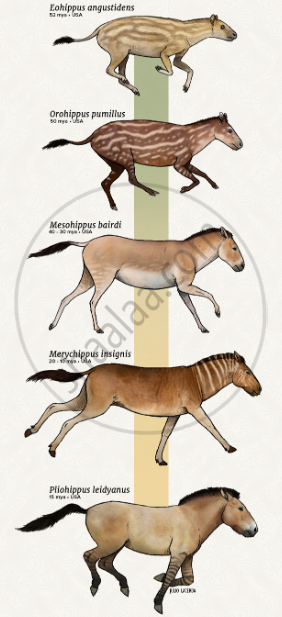
2) Evidence from comparatives morphology and anatomy:
- Similarities and differences are found among organisms of today and those that existed years ago. Such similarities can be interpreted to understand whether common ancestors were shared or not.
- These similarities are of two types:
Homologous Structures:
The organs which have a common origin, embryonic development, and same fundamental structure but perform similar or different functions are called Homologous organs and this phenomenon is called Homology. E.g., of homologous organs:
- Forelimbs of mammals - Whales, bats, cheetahs and humans (all mammals) share similarities in the pattern of bones of forelimbs though these forelimbs perform different functions. In these animals, forelimbs have similar anatomical structures - all of them have humerus, radius, ulna, carpals, metacarpals, and phalanges in their forelimbs.
- Thorn of Bougainvillea and tendril of Cucurbita both are modification of axillary bud.
- Vertebrate hearts or brains
- Mouthparts of insects -
Cockroach - (Biting & chewing)

Honey bee - (lapping & chewing)
Mosquito- (Piercing & sucking)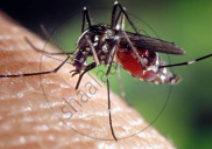
- Testes in male and ovaries in female
- Potato and Ginger - both are modified shoot
- Radish and Carrot - both are modified roots
- Molecular homology - Homology found at the molecular level. For example, the plasma proteins found in the blood of man and apes are similar.
- When the same structures develop in different directions due to adaptations to different needs, this is called divergent evolution.
- Homology indicates common ancestry and is based on divergent evolution.
Analogous structures:
- Analogy - The organs which have different origin and fundamental structures but perform similar functions are called Analogous organs and this phenomenon is called as analogy.
- Examples of analogous organs:
i) Wings of butterfly and birds - They are not anatomically similar structures though they perform similar functions i.e., used for flying.
ii) Eye of the octopus and of mammals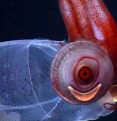
iii) Flippers of Penguins and Dolphins
iv) Sweet potato (root modification) and potato (stem modification)
v) Sting of bee and scorpion
vi) Chloragogen cells of earthworms and liver of vertebrates
Evidence from vestigial organs -
- The organs which are present in reduced form and do not perform any function in the body but are functional in related animals are called vestigial organs.
- They are remnants of organs which were complete and functional in their ancestors. e.g., Nictitating membrane
- Muscles of pinna (auricular muscles)

- Vermiform appendix (Caecum)

- Coccyx

- Canine teeth Third molars (wisdom teeth)
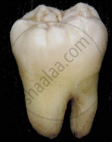
- Body hair

- Nipples in males

- Segmented muscles of abdomen
Evidence from Atavism (Reversion) -
- Sometimes in some individuals such characters suddenly appear which were supposed to be present in their ancestors but were lost during the course of evolution, this phenomenon is known as atavism or reversion.
- Atavism proves that animals developing atavistic structures have evolved from such ancestors in which these structures were fully developed.
- e.g., Tail in newborn baby
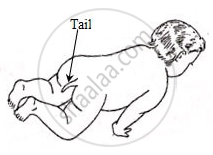
- Extra-long and pointed canine teeth
- Long and thick body hair
- Extra nipples in female
- Cervical fistula (pharyngeal gills slits)
Evidences from connecting links -
- Some organisms possess characters of two separate groups called as connecting links, which proves that members of higher groups have evolved from the lower group.
- Examples:
- Virus - Between living and non-living
- Euglena - Between plants and animals
- Proterospongia - Between protozoa and porifera
- Neopilina - Between annelida and mollusca
- Peripatus - Between annelida and arthropoda
- Balanoglossus - Between non chordata and chordta
- Chimera - Between cartilaginous and bony fishes
- Protopterus (Lung fish) - Between fishes and amphibian
- Seymauria - Between amphibia and reptilia
- Archaeopteryx - Between reptiles and birds
- Platypus and Echidna - Between reptiles and mammals
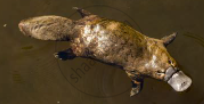
Evidences from biochemistry -
- Similarities in proteins and genes performing a given function among diverse organisms give clues to common ancestry.
- Composition and structure of protoplasm, enzymes, hormones, DNA, blood in chordates is also almost same. It shows that organisms shared ancestors in recent or distant past.
4) Evidences from embryology -
- Baer's law: This was proposed by Von Baer (father of embryology). He stated that "in embryonic stages, general characters appear firstly and specialized characters appear later".
- Muller proposed 'Recapitulation theory', According to which "Ontogeny recapitulates phylogeny". Ontogeny is the study of the embryological development of individual organisms while phylogeny is the evolutionary history of that organism.
- In 1866, Ernst Haeckel explained it in detail and called it 'Biogenetic law'.
- Ernst Haeckel law was based on the observation of certain features during the embryonic stage common to all vertebrates that are absent in adult, for example, the embryos of all vertebrates including humans develop a arow of vestigial gill slits just behind the head but it is functional organ only in fish and not found in any other adult vertebrates.
- It means an organism shows its ancestral adult stages during its embryonic development. In other words, embryos of advanced species pass through stages represented by adult organisms of more primitive species.
- It shows that all organisms have a common ancestry.
- Interestingly, Von Baer (1828) had disproven the 'Biogenetic law' before Haeckel invented it. He observed that embryos never pass through the adult stages of other animals.
- Examples:
(1) The tadpole larva of amphibians resembles with fishes. This indicates the origin of amphibians from fishes.
(2) During the development of the heart in higher vertebrates like birds and mammals, it initially exhibits the 2 - chambered states same as fishes. Later on, it develops into 3- chambered as in amphibians and reptiles and finally, in the last embryonic stages it becomes 4- chambered as such in the adults. This proves that all vertebrates have evolved from common fish-like ancestors and also that both birds and mammals have evolved from reptiles.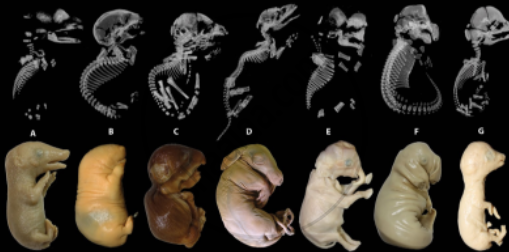
5) Evidence from biogeographical distribution -
- The study of the geographical distribution of animals and plant species in different parts of the earth is called biogeography.
- On the basis of fauna and flora, Alfred Russel Wallace divided the whole world into six biogeographical regions called realms.
- Nearctic - North America
- Neotropical - South America
- Ethiopian - Africa
- Palearctic - Europe
- Oriental - Asia
- Australian – Australia
- It is believed that millions of years ago all the continents were present in the form of a single land mass called Pangea. Later due to continental drift these land masses got separated from each other by the seas. As these continents had different climates so plants and animals evolved there were of different varieties.
- In South America, mammals resembling horses, hippopotamus, bears, rabbits, etc. were present. Due to continental drift, when South America joined North America, these animals were overridden by North American fauna.
- In prehistoric times Australia was a part of the Asian continent. After the evolution of prototherians from reptiles, Australia got separated from mainland of Asia. Later on, eutherian mammals evolved in Asia which were carnivores in nature and they destroyed prototherians and marsupials from Asia but pouched mammals (marsupials) of Australia survived because of lack of competition from any other mammals.
- Today eutherians are also found in Australia because some of them evolved there and some were later transported by man.
Notes
6. Molecular evidence:
Molecular evolution is the process of change in the sequence composition of molecules such as DNA, RNA, and proteins across generations. It uses principles of evolutionary biology and population genetics to explain patterns in the changes of molecules. One of the most useful advancement in the development of molecular biology is proteins and other molecules that control life processes are conserved among species. A slight change that occurs over time in these conserved molecules (DNA, RNA, and protein) are often called molecular clocks. Molecules that have been used to study evolution are cytochrome c (respiratory pathway) and rRNA (protein synthesis).
7. Evolution by natural selection (Industrial melanism):
- Natural selection can be explained clearly through industrial melanism.
- Industrial melanism is a classical case of Natural selection exhibited by the peppered moth, Biston betularia. These were available in two colours, white and black. Before industrialization peppered moth both white and black coloured were common in England.
- Pre-industrialization (1850): There was white-coloured lichen that covered the trees. In that background, the white-winged moths survived but the dark-coloured moths were picked out by predators.
- Post industrialization (1920): Post industrialization, the tree trunks became dark due to smoke and soot let out from the industries. The black moths camouflaged on the dark bark of the trees and the white moths were easily identified by their predators. Hence the dark-coloured moth population was selected and their number increased when compared to the white moths. Nature offered positive selection pressure to the black-coloured moths.
- The above proof shows that in a population, organisms that can adapt will survive and produce more progenies resulting in an increase in population through natural selection.
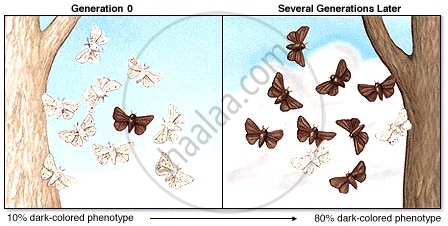
8. Evolution by anthropogenic (by human) action:
- Artificial selection is a byproduct of human exploitation of forests, oceans and fisheries or the use of pesticides, herbicides or drugs.
- For hundreds of years, humans have selected various types of dogs, all of which are variants of a single species of dog.
- If human beings can produce new varieties in short period, then “nature” with its vast resources and long duration can easily produce new species by selection.
